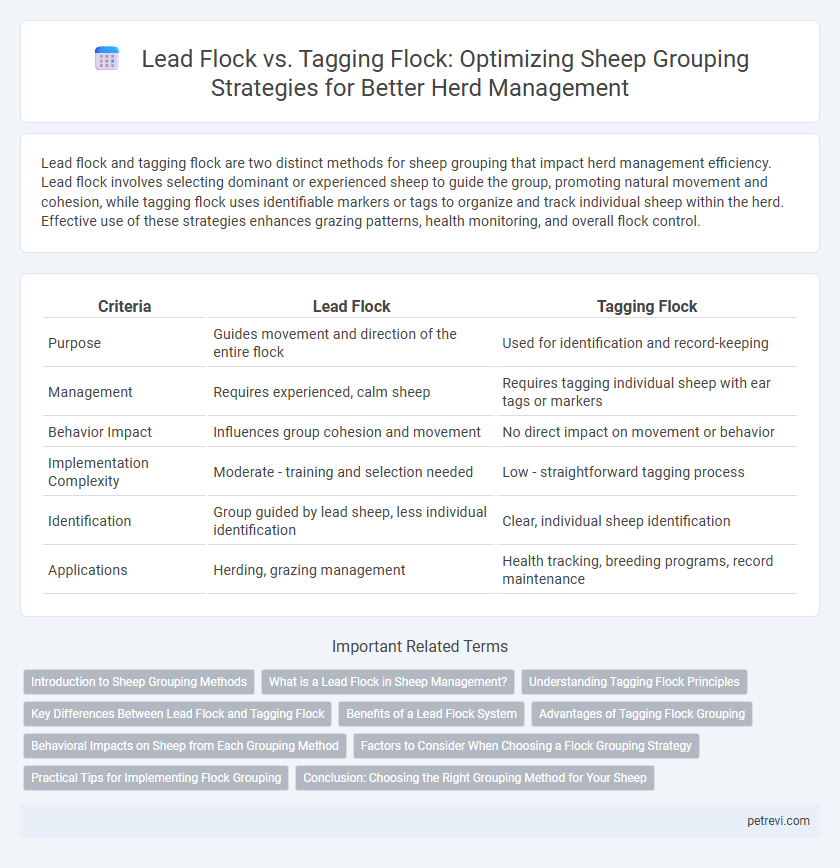Lead flock and tagging flock are two distinct methods for sheep grouping that impact herd management efficiency. Lead flock involves selecting dominant or experienced sheep to guide the group, promoting natural movement and cohesion, while tagging flock uses identifiable markers or tags to organize and track individual sheep within the herd. Effective use of these strategies enhances grazing patterns, health monitoring, and overall flock control.
Table of Comparison
| Criteria | Lead Flock | Tagging Flock |
|---|---|---|
| Purpose | Guides movement and direction of the entire flock | Used for identification and record-keeping |
| Management | Requires experienced, calm sheep | Requires tagging individual sheep with ear tags or markers |
| Behavior Impact | Influences group cohesion and movement | No direct impact on movement or behavior |
| Implementation Complexity | Moderate - training and selection needed | Low - straightforward tagging process |
| Identification | Group guided by lead sheep, less individual identification | Clear, individual sheep identification |
| Applications | Herding, grazing management | Health tracking, breeding programs, record maintenance |
Introduction to Sheep Grouping Methods
Lead flock method relies on training a small number of sheep to guide the movement and behavior of the entire group, leveraging natural herd instincts for efficient management. Tagging flock involves attaching physical or electronic identifiers to individual sheep, facilitating precise tracking and monitoring of each animal's location and health. Both methods optimize flock organization but differ in approach: lead flock emphasizes social dynamics, while tagging flock focuses on technological identification.
What is a Lead Flock in Sheep Management?
A lead flock in sheep management refers to a designated group of sheep that guides the movement and behavior of the entire herd during grazing and herding activities. This lead group typically consists of experienced or dominant sheep that instinctively follow pastures and water sources, influencing the rest of the flock to follow their direction. Using a lead flock optimizes grazing efficiency and reduces stress, as the other sheep naturally follow the familiar leaders without the need for extensive handling or herding.
Understanding Tagging Flock Principles
Tagging flock principles involve assigning distinctive markers or electronic IDs to individual sheep within a group to enhance traceability, health monitoring, and management efficiency. Unlike a lead flock, which relies on dominant or experienced individuals to guide group movement, tagging focuses on precise identification and data collection for each sheep, enabling targeted care and streamlined record-keeping. Implementing tagging flock strategies optimizes flock management by improving tracking accuracy and facilitating rapid response to health or breeding needs.
Key Differences Between Lead Flock and Tagging Flock
Lead flock consists of highly experienced and dominant sheep that guide the movement and behavior of the entire group, while tagging flock comprises younger or less dominant sheep that follow the lead flock's patterns. Lead flock members influence grazing patterns, navigation, and predator avoidance, playing a crucial role in decision-making within the herd. Tagging flock relies on cues from the lead flock for safety and direction, contributing to the social structure but not initiating group activities.
Benefits of a Lead Flock System
A Lead Flock system enhances sheep management by streamlining group movement and reducing labor requirements through trained lead sheep guiding the herd. This method minimizes stress and enhances grazing efficiency, promoting better weight gain and overall flock health. Compared to tagging, the lead flock approach offers improved behavioral cohesion and simplifies tracking without relying heavily on individual identification methods.
Advantages of Tagging Flock Grouping
Tagging flock grouping enhances sheep management by providing precise identification for each animal, improving tracking of health, breeding, and movement patterns. This method reduces the risk of miscommunication and errors common in lead flock systems, leading to better flock organization and productivity. Accurate tagging supports efficient data collection and individualized care, optimizing overall flock performance and welfare.
Behavioral Impacts on Sheep from Each Grouping Method
Lead flock grouping leverages sheep's natural herding instincts by assigning a dominant leader, which reduces stress through clear social hierarchy and promotes cohesive movement. Tagging flock method relies on visual tags for individual identification, often causing mild disruptions in social bonds and increasing anxiety due to less intuitive leadership cues. Behavioral studies indicate lead flocking enhances group synchronization and lowers cortisol levels compared to tagging, which can trigger increased vigilance and fragmentation within sheep groups.
Factors to Consider When Choosing a Flock Grouping Strategy
Choosing between lead flock and tagging flock methods for sheep grouping depends on factors such as ease of management, flock behavior, and environmental conditions. Lead flock strategies work well when strong hierarchical structures exist, promoting natural movement and grazing patterns, while tagging flock methods provide precise individual tracking and health monitoring. Consider flock size, terrain complexity, and the desired level of data collection to optimize the grouping strategy for productivity and animal welfare.
Practical Tips for Implementing Flock Grouping
Lead flock method uses a trained sheep or ewe to guide and organize other sheep during movement, improving cohesion and reducing stress in the herd. Tagging flock involves marking individual sheep with identifiable tags or collars, facilitating easy tracking, health monitoring, and management within large groups. Combining both methods enhances overall flock control, ensuring efficient grouping and streamlined management for sheep producers.
Conclusion: Choosing the Right Grouping Method for Your Sheep
Lead Flock grouping offers precise control by using a trained lead sheep to guide the herd, enhancing movement coordination and reducing stress during handling. Tagging Flock involves marking individual sheep for easy identification, facilitating management tasks like monitoring health and breeding records. Selecting the appropriate method depends on farm size, management goals, and resources, with Lead Flock suited for dynamic herding situations and Tagging Flock ideal for detailed individual tracking.
Lead Flock vs Tagging Flock for Sheep Grouping Infographic

 petrevi.com
petrevi.com